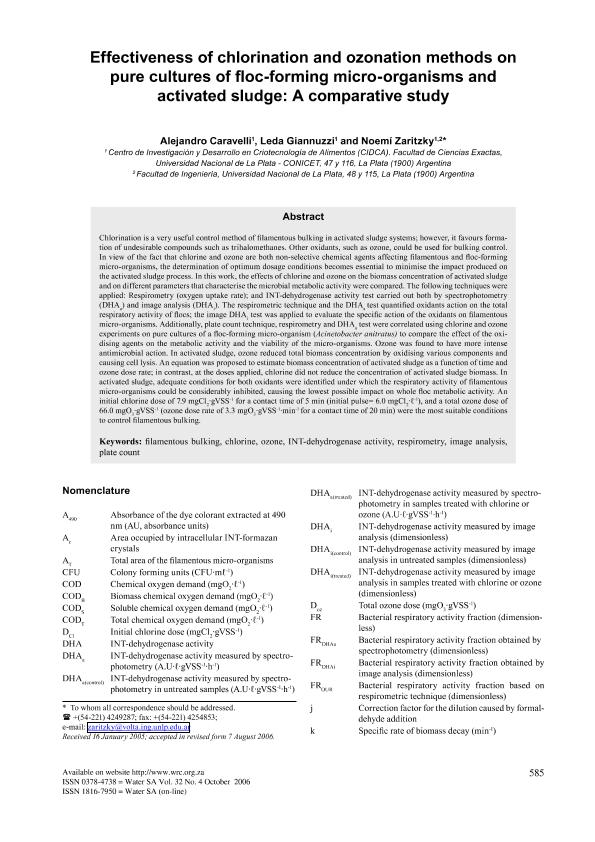Mostrar el registro sencillo del ítem
dc.contributor.author
Caravelli, Alejandro Horacio

dc.contributor.author
Giannuzzi, Leda

dc.contributor.author
Zaritzky, Noemi Elisabet

dc.date.available
2020-10-14T17:14:59Z
dc.date.issued
2007-12
dc.identifier.citation
Caravelli, Alejandro Horacio; Giannuzzi, Leda; Zaritzky, Noemi Elisabet; Effectiveness of chlorination and ozonation methods on pure cultures of floc-forming micro-organisms and activated sludge: A comparative study; Water Research Commission; Water S.a.; 32; 4; 12-2007; 585-595
dc.identifier.issn
0378-4738
dc.identifier.uri
http://hdl.handle.net/11336/115898
dc.description.abstract
Chlorination is a very useful control method of filamentous bulking in activated sludge systems; however, it favours formation of undesirable compounds such as trihalomethanes. Other oxidants, such as ozone, could be used for bulking control. In view of the fact that chlorine and ozone are both non-selective chemical agents affecting filamentous and floc-forming micro-organisms, the determination of optimum dosage conditions becomes essential to minimise the impact produced on the activated sludge process. In this work, the effects of chlorine and ozone on the biomass concentration of activated sludge and on different parameters that characterise the microbial metabolic activity were compared. The following techniques were applied: Respirometry (oxygen uptake rate); and INT-dehydrogenase activity test carried out both by spectrophotometry (DHAa) and image analysis (DHAi). The respirometric technique and the DHAa test quantified oxidants action on the total respiratory activity of flocs; the image DHAi test was applied to evaluate the specific action of the oxidants on filamentous micro-organisms. Additionally, plate count technique, respirometry and DHAa test were correlated using chlorine and ozone experiments on pure cultures of a floc-forming micro-organism (Acinetobacter anitratus) to compare the effect of the oxidising agents on the metabolic activity and the viability of the micro-organisms. Ozone was found to have more intense antimicrobial action. In activated sludge, ozone reduced total biomass concentration by oxidising various components and causing cell lysis. An equation was proposed to estimate biomass concentration of activated sludge as a function of time and ozone dose rate; in contrast, at the doses applied, chlorine did not reduce the concentration of activated sludge biomass. In activated sludge, adequate conditions for both oxidants were identified under which the respiratory activity of filamentous micro-organisms could be considerably inhibited, causing the lowest possible impact on whole floc metabolic activity. An initial chlorine dose of 7.9 mgCl2·gVSS-1 for a contact time of 5 min (initial pulse= 6.0 mgCl2·ℓ-1), and a total ozone dose of 66.0 mgO3·gVSS-1 (ozone dose rate of 3.3 mgO3·gVSS-1·min-1 for a contact time of 20 min) were the most suitable conditions to control filamentous bulking.
dc.format
application/pdf
dc.language.iso
eng
dc.publisher
Water Research Commission

dc.rights
info:eu-repo/semantics/openAccess
dc.rights.uri
https://creativecommons.org/licenses/by-nc-sa/2.5/ar/
dc.subject
Filamentous bulking
dc.subject
Chlorine, ozone
dc.subject
INT-dehydrogenase activity
dc.subject
Respirometry
dc.subject
Image analysis
dc.subject
Plate count
dc.subject.classification
Alimentos y Bebidas

dc.subject.classification
Otras Ingenierías y Tecnologías

dc.subject.classification
INGENIERÍAS Y TECNOLOGÍAS

dc.title
Effectiveness of chlorination and ozonation methods on pure cultures of floc-forming micro-organisms and activated sludge: A comparative study
dc.type
info:eu-repo/semantics/article
dc.type
info:ar-repo/semantics/artículo
dc.type
info:eu-repo/semantics/publishedVersion
dc.date.updated
2020-09-25T16:53:32Z
dc.identifier.eissn
1816-7950
dc.journal.volume
32
dc.journal.number
4
dc.journal.pagination
585-595
dc.journal.pais
Sudáfrica

dc.journal.ciudad
Petoria
dc.description.fil
Fil: Caravelli, Alejandro Horacio. Provincia de Buenos Aires. Gobernación. Comisión de Investigaciones Científicas. Centro de Investigación y Desarrollo en Criotecnología de Alimentos. Consejo Nacional de Investigaciones Científicas y Técnicas. Centro Científico Tecnológico Conicet - La Plata. Centro de Investigación y Desarrollo en Criotecnología de Alimentos. Universidad Nacional de La Plata. Facultad de Ciencias Exactas. Centro de Investigación y Desarrollo en Criotecnología de Alimentos; Argentina
dc.description.fil
Fil: Giannuzzi, Leda. Provincia de Buenos Aires. Gobernación. Comisión de Investigaciones Científicas. Centro de Investigación y Desarrollo en Criotecnología de Alimentos. Consejo Nacional de Investigaciones Científicas y Técnicas. Centro Científico Tecnológico Conicet - La Plata. Centro de Investigación y Desarrollo en Criotecnología de Alimentos. Universidad Nacional de La Plata. Facultad de Ciencias Exactas. Centro de Investigación y Desarrollo en Criotecnología de Alimentos; Argentina
dc.description.fil
Fil: Zaritzky, Noemi Elisabet. Provincia de Buenos Aires. Gobernación. Comisión de Investigaciones Científicas. Centro de Investigación y Desarrollo en Criotecnología de Alimentos. Consejo Nacional de Investigaciones Científicas y Técnicas. Centro Científico Tecnológico Conicet - La Plata. Centro de Investigación y Desarrollo en Criotecnología de Alimentos. Universidad Nacional de La Plata. Facultad de Ciencias Exactas. Centro de Investigación y Desarrollo en Criotecnología de Alimentos; Argentina. Universidad Nacional de La Plata. Facultad de Ingeniería. Departamento de Ingeniería Química; Argentina
dc.journal.title
Water S.a.

dc.relation.alternativeid
info:eu-repo/semantics/altIdentifier/doi/http://dx.doi.org/10.4314/wsa.v32i4.5283
dc.relation.alternativeid
info:eu-repo/semantics/altIdentifier/url/https://tinyurl.com/y4kq9zcf
Archivos asociados
